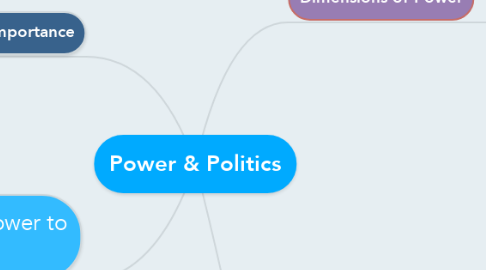
1. Importance
1.1. Understand how as an employee, you will be affected by use of power by others
1.1.1. More/less coercive
1.1.2. More/less hidden
1.2. Understand how you can exercise power responsibly
1.3. Provide managers with more “tools” to manage complex organizations and the means to understand the ethical implications of using those tools
2. Power - capacity to influence the behaviour of others
2.1. Politically aware
2.2. Common interest
2.3. Politically unaware
2.4. Self interest
3. Politics - the exercise of power to influence outcomes
4. Dimensions of Power
4.1. 1st
4.1.1. DEFEAT resistance
4.1.2. Resources & Power
4.1.2.1. Reward
4.1.2.1.1. Tangible/intangible ways to reward and punish ppl
4.1.2.2. Coercive
4.1.2.2.1. Injure/damage somebody
4.1.2.3. Authority
4.1.2.3.1. Formal position in hierarchy
4.1.2.4. Referent
4.1.2.4.1. Establish personal rapport
4.1.2.4.2. Charisma
4.1.2.5. Information
4.1.2.5.1. Have info that others dont have
4.1.2.6. Expert
4.1.2.6.1. Credibility - valued acheivements
4.1.2.6.2. Do what others cant
4.1.2.7. Affiiation
4.1.2.7.1. Connected to powerful people (political access)
4.1.2.8. Group Support
4.1.2.8.1. Having support of many ppl
4.1.2.9. Budgets & Equipment
4.1.2.9.1. allocate budgets and equipment to others
4.1.3. Control of (scarce,valued resources on which others depend)
4.1.4. Relational, context-specific and dynamic
4.1.5. Example
4.1.5.1. Intention: someone (A) wants to get somebody else (B) to do something they would not otherwise do
4.1.5.2. Opposition: B’s opposition is directly confronted by A
4.1.5.3. Action: A mobilizes resources
4.1.5.4. Power use: relatively visible
4.1.5.5. Conflict: overt (done openly/visible)
4.2. 2nd
4.2.1. SIDELINE resistance
4.2.1.1. Control of access to decision-making arena
4.2.1.2. What gets discussed (what's on the agenda?)
4.2.1.3. When and how it gets discussed
4.2.1.4. Criteria for decision-making (who gets to vote)
4.2.2. Example
4.2.2.1. Intention: Management Team wants increase the working hours for the workforce
4.2.2.2. Opposition: Workforce does not like this
4.2.2.3. Action: Management Team manages decision making processes by only allowing managers to vote on the issu
4.2.2.4. Power use: less visible (behind closed doors
4.2.2.5. Conflict: sidelined (possibly only for a while)
4.3. 3rd
4.3.1. PREVENT resistance
4.3.2. Managing MEANING
4.3.2.1. Meaning is created for desired outcomes so that they are seen as legitimate, inevitable, natural, beneficial
4.3.2.2. Associating outcomes with symbols and skillful use of language
4.3.2.3. opposition because outcomes are accepted
4.3.2.4. Factory Closure
4.3.2.4.1. Managerial goodwill
4.3.2.4.2. Consultation
4.3.2.4.3. Redundancy Compensatio
4.3.2.4.4. Legitimizing the Decision
4.3.3. Example
4.3.3.1. Intention: A wants to get B to do something they would not otherwise do
4.3.3.2. Opposition: B’s opposition is pre-emptively eliminated by A by getting B to desire what A wants also
4.3.3.3. Action: A manages meaning making processes to control and manipulate
4.3.3.4. Power use: almost invisibl
4.3.3.5. Conflict: averted (until meaning is contested)
